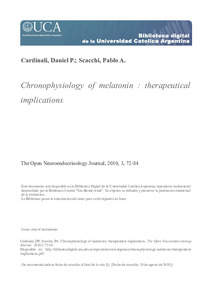Por favor, use este identificador para citar o enlazar este ítem:
https://repositorio.uca.edu.ar/handle/123456789/1629| Campo DC | Valor | Lengua/Idioma |
|---|---|---|
| dc.contributor.author | Cardinali, Daniel Pedro | es |
| dc.contributor.author | Scacchi Bernasconi, Pablo A. | es |
| dc.date.accessioned | 2019-05-02T14:01:11Z | - |
| dc.date.available | 2019-05-02T14:01:11Z | - |
| dc.date.issued | 2010 | - |
| dc.identifier.citation | Cardinali, D. P., Scacchi, P. A. Chronophysiology of melatonin : therapeutical implications [en línea]. The Open Neuroendocrinology Journal. 2010, 3. Disponible en: https://repositorio.uca.edu.ar/handle/123456789/1629 | es |
| dc.identifier.uri | https://repositorio.uca.edu.ar/handle/123456789/1629 | - |
| dc.description.abstract | Abstract: Normal circadian rhythms are synchronized to a regular 24 hr environmental light/dark cycle. Both the suprachiasmatic nucleus (SCN) and melatonin are essential for this adaptation. Melatonin exerts its chronophysiological action in part by acting through specific receptors (MT1, MT2) which have been identified in the plasma membrane of SCN as well as in several neural and non-neural tissues. Both receptors have been cloned and share general features with other G protein linked receptors. Melatonin also exerts direct effects on intracellular proteins such as calmodulin or tubulin and has strong free radical scavenger properties which are non-receptor mediated. Within the SCN, melatonin reduces neuronal activity in a time-dependent manner. SCN MT1 and MT2 receptors appear to be insensitive during the day, but sensitive at dusk and dawn (MT2; causes phase shifts) or during early night period (MT1; decreases neuronal firing rate). Melatonin secreted during nighttime provides enough inertia to resist minor perturbations of the circadian timing system. The disruption of these circadian mechanisms cause a number of sleep disorders named according to the International Classification of Sleep Disorders as circadian rhythm sleep disorders (CRSDs). CRSDs include delayed or advanced sleep phase syndromes, non 24 hr sleep/wake rhythm disorder, time zone change syndrome (“jet lag”) and shift work sleep disorder. Disturbances in the circadian phase position of plasma melatonin levels have been found in all these disorders. In addition, co-morbility of severe circadian alterations with neurodegenerative diseases like Alzheimer´disease (AD) has been documented. Although further research involving larger number of patients suffering CRSDs is required, currently there is sufficient evidence to implicate endogenous melatonin as an important mediator in CRSD pathophysiology. Melatonin and its analogs can constitute useful therapeutic tools to treat disturbed sleep-wake rhythms in CRSDs. Melatonin secretion decreases in AD patients and its administration improves sleep efficiency, sundowning and cognitive function. This effect can be particularly important in mild cognitive impairment, an etiologically heterogeneous syndrome characterized by cognitive impairment preceding dementia. | es |
| dc.format | application/pdf | es |
| dc.language | eng | es |
| dc.language.iso | eng | es |
| dc.rights | Acceso Abierto | es |
| dc.rights.uri | https://creativecommons.org/licenses/by-nc-sa/4.0/ | es |
| dc.source | The Open Neuroendocrinology Journal. 2010, 3 | es |
| dc.subject | RITMO CIRCADIANO | es |
| dc.subject | RECEPTORES DE MELATONINA | es |
| dc.subject | ENFERMEDAD DE ALZHEIMER | es |
| dc.subject | TRASTORNOS DEL SUEÑO | es |
| dc.subject | MELATONINA | es |
| dc.subject | NUCLEO SUPRAQUIASMATICO | es |
| dc.title | Chronophysiology of melatonin : therapeutical implications | es |
| dc.type | Artículo | es |
| uca.path | Facultad de Ciencias Médicas|Departamento de Docencia e Investigación | es |
| uca.disciplina | MEDICINA | es |
| uca.filename | /home/data-uca-generic/folder_generic/IIBiomedicas/chronophysiology-melatonin-therapeutical-implications/metadata.xml | es |
| uca.issnrd | 1 | es |
| uca.version | publishedVersion | es |
| item.grantfulltext | open | - |
| item.fulltext | With Fulltext | - |
| item.languageiso639-1 | en | - |
| crisitem.author.dept | Consejo Nacional de Investigaciones Científicas y Técnicas | - |
| crisitem.author.dept | Instituto de Investigaciones Biomédicas - BIOMED | - |
| crisitem.author.dept | Facultad de Ciencias Médicas | - |
| crisitem.author.orcid | 0000-0002-0813-9088 | - |
| crisitem.author.parentorg | Facultad de Ciencias Médicas | - |
| crisitem.author.parentorg | Pontificia Universidad Católica Argentina | - |
| Aparece en las colecciones: | Artículos | |
Ficheros en este ítem:
| Fichero | Descripción | Tamaño | Formato | |
|---|---|---|---|---|
| chronophysiology-melatonin-therapeutical-implications.pdf | 334,39 kB | Adobe PDF |  Visualizar/Abrir |
Visualizaciones de página(s)
118
comprobado en 30-abr-2024
Descarga(s)
65
comprobado en 30-abr-2024
Google ScholarTM
Ver en Google Scholar
Este ítem está sujeto a una Licencia Creative Commons

